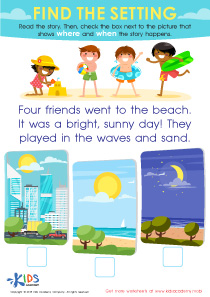Identifying shapes Easy Worksheets for Ages 4-9
3 filtered results
-
From - To
Discover fun and engaging worksheets designed to help children aged 4-9 master shape identification. Our age-appropriate activities, available on Kids Academy, make learning enjoyable through coloring, tracing, and matching exercises that reinforce knowledge of different shapes. These easy-to-use, printable worksheets are perfect for both classroom use and at-home learning, laying a strong foundation for geometry. Boost your child's confidence and skills by integrating these expertly crafted resources into their daily routine. Dive into our collection to support your child's early math development and watch them thrive as they explore the world of shapes.


Two–Dimensional Shapes: Vertices Printable


Robot Fun Worksheet


Help Sarah Be on Time! Worksheet
Identifying shapes is a critical early learning skill for children aged 4-9, providing foundational building blocks for more complex cognitive development. When parents and teachers focus on ensuring that children can easily recognize shapes, they support not just mathematical skills, but also literacy, spatial awareness, and critical thinking.
Shapes are fundamental to understanding geometry, a branch of mathematics essential for academic progress. Being able to identify shapes helps children grasp more complex mathematical concepts, like patterns and symmetry, that they will encounter later in their education. This early skill boosts their confidence and sets a solid groundwork for future learning.
Moreover, recognizing shapes aids in developing reading and writing skills. Shapes form the basis of letters and numbers; a child who can differentiate between circles, triangles, and squares is better equipped to identify letters like 'O,' 'A,' 'M,' and 'W.' This skill is directly linked to their ability to learn to read and write effectively.
In addition, shape recognition plays a crucial role in everyday problem-solving and spatial reasoning. Understanding and manipulating different shapes allow children to better navigate their environment, leading to improved motor skills and better coordination.
In summary, prioritizing shape identification builds a robust educational foundation, enhancing mathematical literacy, reading capabilities, and spatial reasoning, which are essential for children’s academic and personal development.
 Assign to My Students
Assign to My Students

















